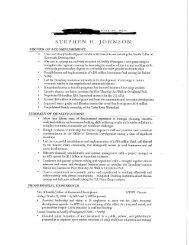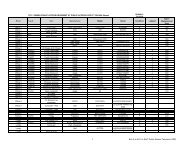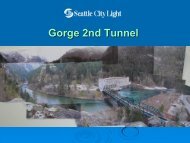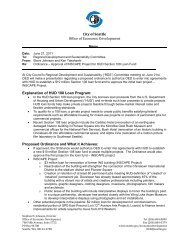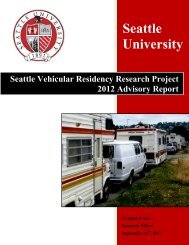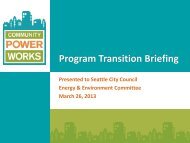2013 Water System Plan, Volume II - Seattle City Clerk's Office - City ...
2013 Water System Plan, Volume II - Seattle City Clerk's Office - City ...
2013 Water System Plan, Volume II - Seattle City Clerk's Office - City ...
Create successful ePaper yourself
Turn your PDF publications into a flip-book with our unique Google optimized e-Paper software.
will typically be at the margins of the street intersection that contains a grid junction<br />
and also intermediate line valves at street margin of the desired location.<br />
E. Clearances<br />
Clearances around a valve are very important to operations and maintenance of the<br />
valve. When placing a valve in a vault, the design engineer should ensure that<br />
maintenance staff will have access to all valve parts for maintenance and enough space<br />
for wrenches and other tools. Typically, a minimum of 1-foot space is needed around all<br />
valves. SPU prefers a 3-foot space.<br />
F. Valve Restraint <strong>System</strong>s<br />
All valves in chambers and those installed on a restrained joint pipe should be fully<br />
restrained. There are several options for restraining valves, including flanges and a<br />
mechanical joint with a wedge restraint gland. The system chosen should be consistent<br />
with other SPU designs and consistent across the project.<br />
G. Valve Replacement<br />
The design engineer should pay close attention to removal of the valve. Valves 16-inch<br />
and larger should have an access hatch directly over the valve, adequately sized to<br />
remove the valve.<br />
Another consideration for valve removal is a dismantling joint. When flanged valves are<br />
installed, the pipeline is extremely tight. If the valve needs to be replaced, unbolting it<br />
may not provide sufficient space to slide the valve out. A dismantling joint has a special<br />
sleeve that can be retracted a few inches. This allows enough extra space to remove the<br />
valve. The dismantling joint also provides some adjustment if a different brand or style<br />
of valve is installed in the future. SPU standard practice is to install a dismantling joint<br />
on valves 16-inch and larger in diameter.<br />
5.6.4.2 Access Ports<br />
SPU installs access ports only on large-diameter (24” or greater) pipelines.<br />
Access ports provide access during construction and to Field Operations and Maintenance staff.<br />
Typical access port sizes are 24-inches in diameter. Typical spacing for a large transmission main<br />
is 1,200 feet except in low areas subject to high groundwater tables. Because access ports<br />
typically only extend 1 to 2 feet above the pipeline surface, they can be buried or encased in a<br />
maintenance hole that extends to the surface. If the access port is fully buried, it should be well<br />
documented on the record drawing (as-built) so future O&M staff can find it. If possible, a<br />
waterline marker should be installed over the access port.<br />
SPU typically installs all access ports vertically. In certain cases, a side-mounted access port may<br />
be necessary given space restrictions. See the DSG standard access port details (Appendix A).<br />
5.6.4.3 Air Gap Structures<br />
Air gaps, also known as goosenecks, are required to prevent cross connections between the<br />
domestic water supply and any other liquid. The ultimate function of this air gap is similar to<br />
that of a check valve. Typically, air gap structures are located on facilities (e.g. tanks) or<br />
equipment (e.g. pumps) connected to the system. The gooseneck discharge must be a minimum<br />
of two discharge pipe diameters aboveground or receiving water surface. Floodwater surface<br />
5-34 SPU Design Standards and Guidelines



